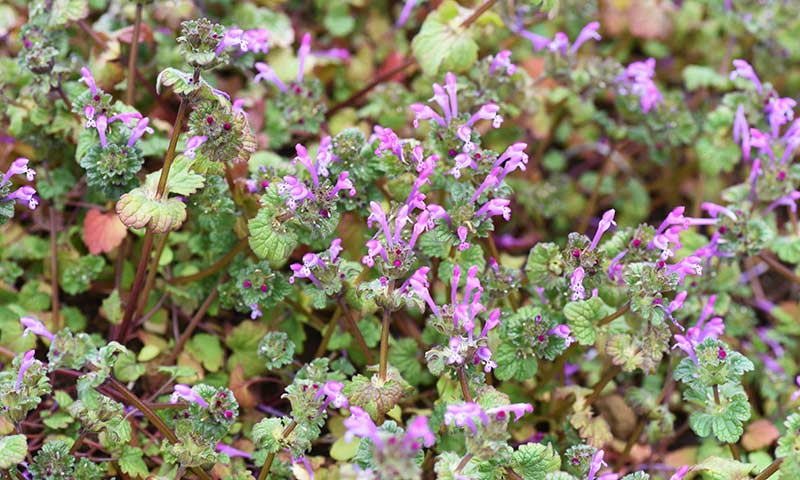HOW TO IDENTIFY HENBIT
Henbit is a cool-season annual weed that belongs to the mint family. Like all mint family members, this broadleaf weed has four-sided stems. The weak, square stems grow up to 15 inches long, but they usually lie close to the ground. The stems turn purple-red with age. Unlike most mints, this lawn weed has very little odor, even when crushed.
Henbit's hairy, circular leaves have rounded, toothed margins. The lower leaves have long leafstalks called petioles that attach to the stem. But the upper leaves connect directly to the stem. Known as sessile leaves, they encircle the stem right below henbit's flower clusters. The tubular, two-lipped flowers look like tiny pinkish-purple orchids.
Henbit is often mistaken for purple deadnettle and creeping charlie, also mint family members. Unlike henbit, purple deadnettle has triangular, purplish upper leaves that have petioles. Creeping Charlie's spreading stems root at nodes along their length, but henbit stems root only near the plant's base.
WHERE AND WHY HENBIT GROWS
Henbit grows throughout the United States, though it's most common in the East and South. Some southern farmers use henbit for erosion control, but most lawn owners consider this plant a weed. Once it breaches its agricultural boundaries, henbit's invasive nature can displace turf grasses. It's particularly aggressive in newly seeded lawns.
This annual weed flourishes in cool, moist, shaded areas where it outcompetes grass for water and nutrients. Good cultural practices, such as proper mowing, fertilization, irrigation and soil aeration can restore balance and favor vigorous turf. A single henbit plant can produce more than 2,000 seeds.
HOW TO CONTROL HENBIT
When treating henbit or other lawn weeds, always read product labels and make sure the label lists your grass type. Some lawn grasses are sensitive to herbicides, so always double-check. Herbicides can also damage new grass seedlings of any type, so only treat established lawn grasses. For best results, treat henbit when small, new plants emerge.
Image Herbicides offer several highly effective liquid products to kill or control henbit:
- Image Herbicides Crabgrass, Nutsedge & Weed Killer for Lawns, available in Ready-to-Spray and Concentrate versions, is a selective weed killer that starts working on contact. Apply these post-emergent herbicides when henbit is in active growth to kill this weed to the root.
- Image Herbicides Crabgrass & Weed Killer for Lawns, available in Ready-to-Spray and Concentrate, kills even the tough weeds — roots and all. For best results, apply these selective post-emergent herbicides when henbit is small and actively growing.
- Image Herbicides Weed Killer for Southern Lawns, available as Ready-to-Spray and Concentrate products, starts working immediately to kill henbit in southern lawns. These fast-acting herbicides deliver visible results in hours.
Henbit Control Tip: Henbit seeds germinate in late summer to fall. The plants flower and set seed the following spring and summer, then die. To break the cycle, treat henbit as soon as it emerges — before it produces seed for the next round.
If you prefer a granular option for post-emergent weed control, consider Pennington Full Season Weed & Feed 25-0-8. This combination fertilizer and herbicide product controls henbit and feeds your lawn.
Always read product labels thoroughly and follow instructions, including guidelines for lawn grasses, frequency of applications and seasonal maximums that may apply.
HENBIT GALLERY

Henbit Flower Patch

Henbit Patch on Grass

Henbit Patch

Henbit Upper Leaves

Henbit Petioled Leaves and Stem

Henbit Flower Close Up

Henbit Seeds




